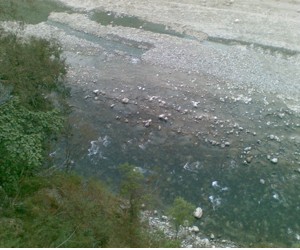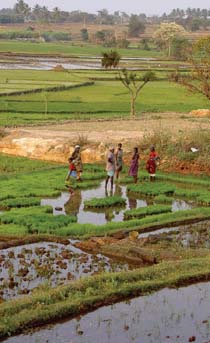Rainfall and other forms of Precipitation
Man-made floods in Orissa in September 2011- Key issues raised by Water Initiatives Orissa
Posted on 06 Oct, 2011 10:24 AMOrissa was hit by two spates of flood in September 2011, the first one being caused by heavy rains in the Mahanadi catchment and release of huge discharges from Hirakud dam. The second one was caused by heavy rains and flooding of Brahmani, Baitarani and Budhabalanga rivers. These floods point to the loopholes in river basin planning and management and calls for urgent attention of planners and policy makers.
Floods in Orissa wreck havoc and an earthquake in Sikkim leads to a trail of destruction - A comprehensive compilation of recent floods and disaster-related news articles
Posted on 01 Oct, 2011 10:04 AM A look at the news in the month of September 2011, indicates that the month has experienced a range of events such as heavy floods in different parts of the country with Orissa being the worst affected state, a major earthquake in the North East with Sikkim being the most affected, reports of flash floods and landslides in various parts of the country as well as reports of heavy rainfall in different parts of the country with indications that the rainfall may further subside in the coming week.
A look at the news in the month of September 2011, indicates that the month has experienced a range of events such as heavy floods in different parts of the country with Orissa being the worst affected state, a major earthquake in the North East with Sikkim being the most affected, reports of flash floods and landslides in various parts of the country as well as reports of heavy rainfall in different parts of the country with indications that the rainfall may further subside in the coming week.
Different designs, same management: A note from Water Initiatives Odisha on Rengali dam and flood management
Posted on 28 Sep, 2011 09:57 AMWater Initiatives Odisha, brings out a special note on this issue in response to the latest spell of the flood disaster in northern Odisha Rivers.
Water conservation through better irrigation
Posted on 26 Sep, 2011 11:30 AMArticle and image courtesy: IndiaWaterReview

The agriculture sector in India, like elsewhere in the world, remains the largest consumer of water. As much as 80-85 per cent of India's available water resources are deployed annually in the agriculture sector, with industry being the second-most largest water consumer. But, contrary to the amount of efforts being put among industrial consumers to bring down their water consumption, agriculturists remain stuck on age-old methods and systems that lead to wastage of water.
So, while industry has been spending money on conducting in house research and development (R&D) to bring down their overall water consumption for making goods and products as well as deploying technologies that treat and reuse water and wastewater better, the agriculture sector has maintained status quo. Across India, farmers are still using flood irrigation methods for their crops. Most of them have not even head of drip irrigation or are so poor that they cannot afford to invest in drip irrigations systems.
Himachal Pradesh state policy on disaster management (2011)
Posted on 25 Sep, 2011 04:28 PMMain hazards that the state is prone to consist of earthquakes, landslides, flash floods, snow storms and avalanches, droughts, dam failures, fires – domestic and wild, accidents – road, rail, air, stampedes, boat capsizing, biological, industrial and hazardous chemicals etc.
Indicators of climate change in the middle Himalaya - A rapid inventory - Current Science
Posted on 22 Sep, 2011 01:22 PMThis article published in the journal Current Science presents the findings of a study that aimed at developing a rapid inventory on the impact of the recent climatic changes on the ecosystem, flora and fauna of the Himalayan region with a special emphasis on livelihoods.
Flood hazard zonation of Assam – An atlas by National Remote Sensing Centre
Posted on 05 Sep, 2011 03:09 PMAssam represents a highly flood-prone region characterized by severe hazards of floods. Although occurrence of flood has been an age-old phenomenon in the riverine areas of this region, the extent of damage caused by floods has increased significantly in recent years.
Forecasting agricultural output using space, agrometeorology and land based observations
Posted on 03 Sep, 2011 06:29 PMThis document presents the proceedings of the annual review meeting by India Meteorological Department (IMD) on “Forecasting Agricultural Output Using Space, Agrometeorology and Land Based Observations” (FASAL) organized at YASHADA, Pune during 1-2 August 2011.
Adaptive water resource management in the Lower Bhavani project command area in Tamil Nadu – A research report by IWMI
Posted on 25 Aug, 2011 11:07 PM
To what extent farmers and water resource managers already practice adaptive management and whether it is practiced in an optimal manner or could there be areas for improvement based on recent advancements in the theory of adaptive management are some of the questions that are particularly appropriate in the light of rapid changes in river basin water use and also in relation to basin closure.
This paper draws on the development and use of water resources in the Lower Bhavani Project (LBP), with the LBP reservoir and the 84,000 hectare (ha) LBP command area. The project diverts water from the Bhavani River, a tributary of the Cauvery River in Tamil Nadu.
Seasonal prediction of the Indian monsoon - A paper from Current Science
Posted on 25 Aug, 2011 02:07 AMThis paper published in Current Science presents the results of the national project on ‘Seasonal Prediction of the Indian Monsoon’ (SPIM), which involved a comparison of the skill of the atmospheric models used in the country for prediction of the summer monsoon, in simulation of the year-to-year variation of the summer monsoon rainfall over the Indian region for 1985–2004.





